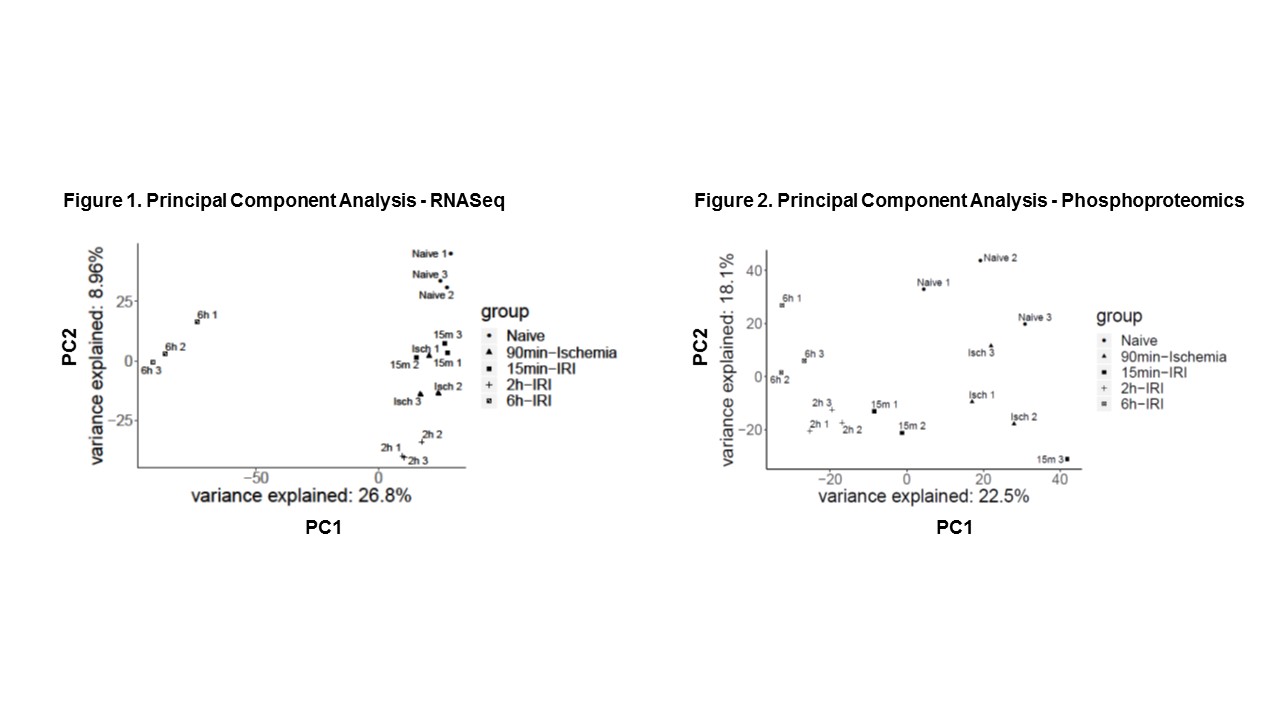Multi-omic Analysis Of Hepatic Ischemia/reperfusion Injury Identifies Novel Targets To Mitigate Hepatocellular Damage
1Surgery, UCLA, Los Angeles, CA, 2Surgery, University of Florida, Gainesville, FL, 3Biostatistics, University of Florida, Gainesville, FL
Meeting: 2019 American Transplant Congress
Abstract number: A108
Keywords: Ischemia, Liver preservation
Session Information
Session Name: Poster Session A: Ischemia Reperfusion & Organ Rehabilition
Session Type: Poster Session
Date: Saturday, June 1, 2019
Session Time: 5:30pm-7:30pm
 Presentation Time: 5:30pm-7:30pm
Presentation Time: 5:30pm-7:30pm
Location: Hall C & D
*Purpose: Hepatic ischemia/reperfusion injury (IRI) is a major risk factor for acute rejection and early graft dysfunction in liver transplantation. The large and complex landscape of regulatory signaling events in IRI has not been systematically characterized. To expand the understanding of the regulatory changes during the early stages of IRI, we performed a systematic transcriptional, proteomic, and phosphoproteomic analysis in a mouse warm hepatic IRI model to confirm previous findings and to explore potential novel pathways to target.
*Methods: Mice were subjected to 70% partial warm ischemia for 90min, followed by 15min, 2h, or 6h of reperfusion. Naïve mice were used as baseline. Hepatic tissues were collected from euthanized mice at each time point, homogenized, and peptides and RNA were extracted for nLC-MSMS and RNASeq analysis, respectively. For the drug studies, mice were treated with Syk inhibitor or Fyn inhibitor for 5 days prior to subjecting them to 70% warm hepatic IRI for 90 minutes. After 6 or 24 hours of reperfusion, cardiac puncture was performed and blood was collected for analysis. Livers were harvested for histopathological and other quantitative analyses.
*Results: Principal component analysis of the RNASeq data resulted in clusters of the technical replicates, as well as gradual progression of the transcriptional profile from ischemia to 2h after IRI. However, after 6h the transcriptional profile was markedly different from the very early stages, indicating a shift in activated signaling pathways. (Figure 1) PCA of proteomic and phosphoproteomic data similarly demonstrated clustering of technical replicates and a difference between the profiles of the early and later time points. (Figure 2)
Characteristic patterns of the early phase of injury include Oxidative Stress Response and JAK-STAT pathways in ischemic tissues, and adipogenesis, fatty acid beta oxidation, and the unfolded protein response pathways as early as 15min after reperfusion. After 2h there is upregulation of macrophage signaling. Finally, the 6h timepoint is characterized by significantly more activity of the acute phase response and sirtuin and IL-6 signaling. Multi-omic analysis identified tyrosine kinases, such as Syk and Fyn, as potential unexamined targets for drug therapy. We confirmed the hypothesis that these newly identified targets play a role in IRI by showing that inhibition of Syk or Fyn mitigates hepatocellular injury in our IRI model. (Figure 3)
*Conclusions: This study substantiates the complex activity of regulatory signaling pathways that have important roles in the progression of hepatic IRI. It identifies both previously unexamined pathways and corroborates previously implicated signals that are valuable potential targets for drug therapy.
To cite this abstract in AMA style:
Duarte S, Boominathan V, Huo Z, Kobayashi A, Kim U, Lai Y, Coito A, Zarrinpar A. Multi-omic Analysis Of Hepatic Ischemia/reperfusion Injury Identifies Novel Targets To Mitigate Hepatocellular Damage [abstract]. Am J Transplant. 2019; 19 (suppl 3). https://atcmeetingabstracts.com/abstract/multi-omic-analysis-of-hepatic-ischemia-reperfusion-injury-identifies-novel-targets-to-mitigate-hepatocellular-damage/. Accessed December 23, 2025.« Back to 2019 American Transplant Congress


